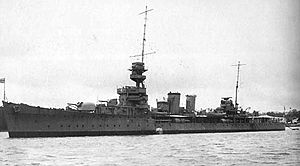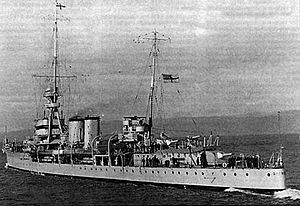HMS Diomede (D92) facts for kids

HMS Diomede in 1938.
|
|
Quick facts for kids History |
|
|---|---|
| Name | Diomede |
| Ordered | March 1918 |
| Builder | Vickers, Barrow-in-Furness |
| Laid down | 3 June 1918 |
| Launched | 29 April 1919 |
| Commissioned | October 1922 |
| Decommissioned | 5 April 1946 |
| In service | 1922 |
| Out of service | 1945 |
| Identification | Pennant number D92 |
| Motto | Fortibus Feroces Frangitur |
| Fate | Sold for scrap 13 May 1946 |
| General characteristics | |
| Class and type | Danae-class cruiser |
| Displacement | 4,850 tons |
| Length | 471 ft 2 in (143.61 m) |
| Beam | 46 ft 3 in (14.10 m) |
| Draught | 14 ft 3 in (4.34 m) |
| Propulsion | 2 Parsons geared turbines driving 2 shafts |
| Speed | 29 knots (54 km/h) |
| Range |
|
| Endurance | 24 days |
| Capacity | 1,060 tons coal/oil |
| Complement | 450 |
| Electronic warfare & decoys |
Type 273 Radar |
| Armament | 6 × 6 in/45 BL Mark XII |
| Armour |
|
The HMS Diomede was a type of warship called a Danae-class cruiser, built for the Royal Navy of the United Kingdom. It was constructed by Vickers Armstrong in Barrow-in-Furness. The ship was finished too late to join World War I. It was completed at the Royal Dockyard in Portsmouth.
Between the two World Wars, the Diomede sailed in different parts of the world. It served near China, in the Pacific Ocean, and around the East Indies. From 1936, it was kept in reserve. During World War II, the Diomede served for four tough years. It even chased a German ship called the Idarwald. The German crew sank their own ship, but the Diomede rescued and captured them. From July 1942 to September 1943, it was changed into a training ship at Rosyth Dockyard. In 1945, it was put into reserve again, and then taken apart for scrap metal a year later.
Building the Diomede
During World War I, British intelligence heard that Germany was building new cruisers. These German ships might have been stronger than the British C-class light cruisers. To keep a strong navy, Britain decided to build an improved C-class ship. This new design would have an extra 6-inch gun at the front.
In September 1916, the first three ships of this new class were launched. They were the Danae, Dauntless, and Dragon. A second group of ships was ordered in July 1917. These were the Delhi, Dunedin, and Durban.
The Diomede was part of a third group ordered in March 1918. This group was supposed to have six ships. However, when World War I ended, only two were built: the Diomede and Despatch. The Diomede was started at Vickers Armstrong in Barrow-in-Furness in mid-1918. After it was launched in 1919, work on it stopped for a while.
In 1922, the ship was towed to the Royal Dockyard in Portsmouth. It was finally finished on February 22, 1922. Like the second group of Danae-class ships, the Diomede had a special "trawler bow" shape at the front. The Diomede was also special because it had an experimental, fully covered 6-inch gun at the very front. Before it was finished, there was talk of turning it into a royal yacht, but this idea was never used.
Early Years of Service
After it was officially ready for duty, the Diomede joined the 5th Light Cruiser Squadron in 1922. This squadron was based at the China Station. In 1925, the ship was moved to the New Zealand Division of the Royal Navy at Devonport Naval Base. It served there until 1935. The only break was for a refit (a major repair and upgrade) between 1929 and 1930.
In 1931, the Diomede helped the town of Napier, New Zealand. A terrible earthquake, known as the Hawkes Bay earthquake, had hit the area. The ship provided medical staff, equipment, guards, and firefighters. Its sister ship, the Dunedin, also helped. After the earthquake, the Diomede escorted the damaged ship Veronica to Auckland. The officer in charge at that time (1930-1933) was Commander Victor Crutchley. He later became a famous Admiral during the Pacific War in World War II.
In 1935, the Diomede was told that it and another cruiser in the New Zealand Division would be replaced. They would be replaced by newer Leander-class cruisers. So, the Diomede began its journey back to Britain to be taken out of active service and put into reserve. On the way home, the Abyssinia Crisis started. This was a conflict involving Italy. The Diomede was sent to the British 4th Light Cruiser Squadron, which was part of the East Indies Station based at Aden. It was ready for possible action against the Italian navy.
On March 31, 1936, the cruiser Achilles took its place. The Diomede was then taken out of active service. For the next three years, it was either in the reserve fleet or used to transport troops.
Service in World War II
As war became more likely, the Diomede was brought back into service. On September 3, 1939, it was with the British 7th Cruiser Squadron. This squadron was part of the British Home Fleet and carried out patrols in the northern seas. Before the 7th Cruiser Squadron was sent to the Mediterranean in 1940 (because of the threat from Italy), the Diomede joined the British 8th Cruiser Squadron. This squadron was based at the North America and West Indies Station. Its job was to protect shipping and patrol the area.
On December 8, 1940, the Diomede chased a German ship called the Idarwald. This German ship was a "blockade runner," trying to sneak past naval blockades. The Idarwald was sailing from Tampico, Mexico. Before the Diomede could capture it, the German crew set their ship on fire and sank it off Cabo Corrientes, Cuba. The crew members were rescued by the Diomede and then captured. A US destroyer, the USS Sturtevant, watched the whole event.
In early 1942, the Diomede joined the British 9th Cruiser Squadron. This squadron was part of the South Atlantic and West African Squadron. After more than ten years of active sailing, it was decided that the Diomede should no longer be a front-line warship. So, from July 22, 1942, to September 24, 1943, it was converted into a training ship at Rosyth Dockyard.
When World War II ended, the Diomede was put into reserve again. On April 5, 1946, it was sold to Arnott Young of Dalmuir to be taken apart for scrap metal. It arrived there on May 5, 1946, for breaking up.



